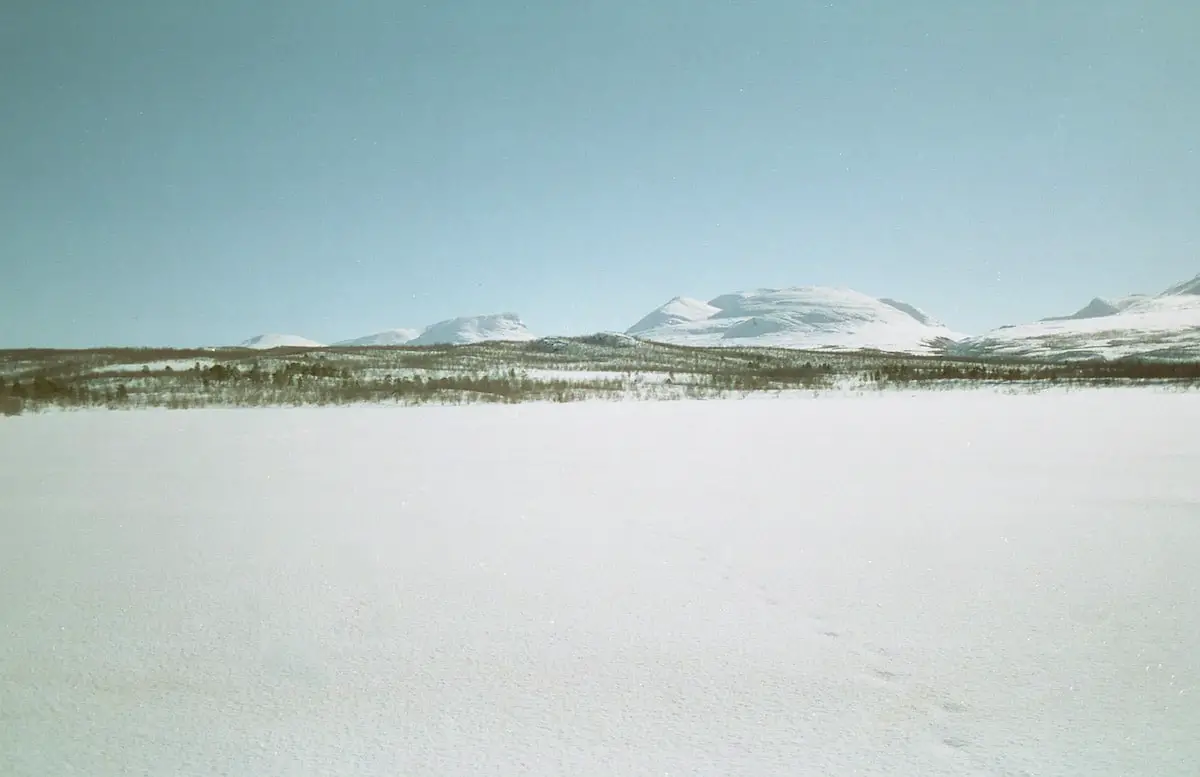Having read a selection of blog posts and reviews about the CineStill range of 120 and 135 films I was intrigued. So during a visit to my favourite camera shop in Stockholm, I was excited to see they stocked CineStill film. I promptly decided to pick up a 35mm roll of their 50D variety so I could give it a try. Following this purchase, the truth is this film ended up sitting in my fridge for almost a year before I decided to give it a spin.
I finally chose to break out this film during a trip to Abisko in Northern Sweden which lies within the Arctic circle (plus a day trip to Narvik in Norway thrown in for good measure). CineStill film is known for a cinematic look (it is repurposed Kodak VISION motion picture film), so I was keen to see the results of using it in a snowy landscape.
My typical go-to film for landscape photography is Kodak Ektar 100 (which I used as a baseline for comparison in this review). To be honest, I really didn’t know what to expect from the CineStill film. Most of the examples online I had seen of this film were of the vibrant street photography or portrait variety. So I knew for landscapes I may be taking a gamble.
The film
Having read that this ISO 50 rated film performs well when overexposed, I shot the film with an exposure compensation of +0.7. I had seen people recommend exposing this film for ISO 25 (+1-stop), but I decided to err on the side of caution and not go the full stop. It should also be noted that overexposure helps account for any metering issues caused by of the abundance of snow.
Obviously, this did lead to slightly slower shutter speeds, but considering the brightness of the landscapes, the use of prime lenses and the stability of my Nikon F4, it was never an issue.

The question really is how did the film perform or I should say; how did the photos of my arctic circle adventure come out? Firstly I will tell you that the film has pretty minimal grain and shows details quite nicely, which is maybe unsurprising for an ISO 50 film. However, to my eyes at least, it is not in the same neighbourhood as the level of detail seen with Kodak Ektar. But that aside, the level of grain is fine landscapes. So far so good.
When it comes to the colour or atheistic of the film, it has a very distinctive look, when compared to say Kodak Ektar. If Ektar gives very modern looking images (as I have seen written on my blog, Ektar is a photographic film for the digital age), CineStill is like a time machine. The hue of this film makes all photos look like they were taken in the 70s and not 2018 (see the Narvik station photo below as an example).




The retro look of the film is ideal for stylistic portrait work or urban photography. For landscape photography, however, this really doesn’t appeal to my aesthetic. It would be a great choice if wanted to give my photos the appearance of being taken in the era of the movie Jaws.
Unfortunately, this is not what I wanted
Final thoughts
If I sound critical of this film, it’s not my intention. I am glad I tried it, but for snowy landscape photography, I think it may not have been the best choice. I think to give CineStill 50D a fair chance I should have tried a different style of photography. Likely shooting colourful cityscapes or urban settings may have been a better assignment for this film. But as landscape photography is my thing, that’s what I ended up using it for.


I have to say, it is an interesting photographic film and I for one am glad it exists, even if it is not really my cup of tea for landscape photography. I will say, however, if you are someone who likes a retro looking high-quality film, then maybe CineStill 50D for you.
My Nikon F4 was used to take all photos in this article, with either the Nikon 28mm f/2.8 AI or 50mm f/2 AI lenses. I had the film developed at my local Fuji centre shop. I scanned the negatives myself using my Epson V370 scanner and did final tweaks such as sharpening and dust removal with Luminar.
~ James
Share your knowledge, story or project
The transfer of knowledge across the film photography community is the heart of EMULSIVE. You can add your support by contributing your thoughts, work, experiences and ideas to inspire the hundreds of thousands of people who read these pages each month. Check out the submission guide here.
If you like what you’re reading you can also help this passion project by heading over to the EMULSIVE Patreon page and contributing as little as a dollar a month. There’s also print and apparel over at Society 6, currently showcasing over two dozen t-shirt designs and over a dozen unique photographs available for purchase.







